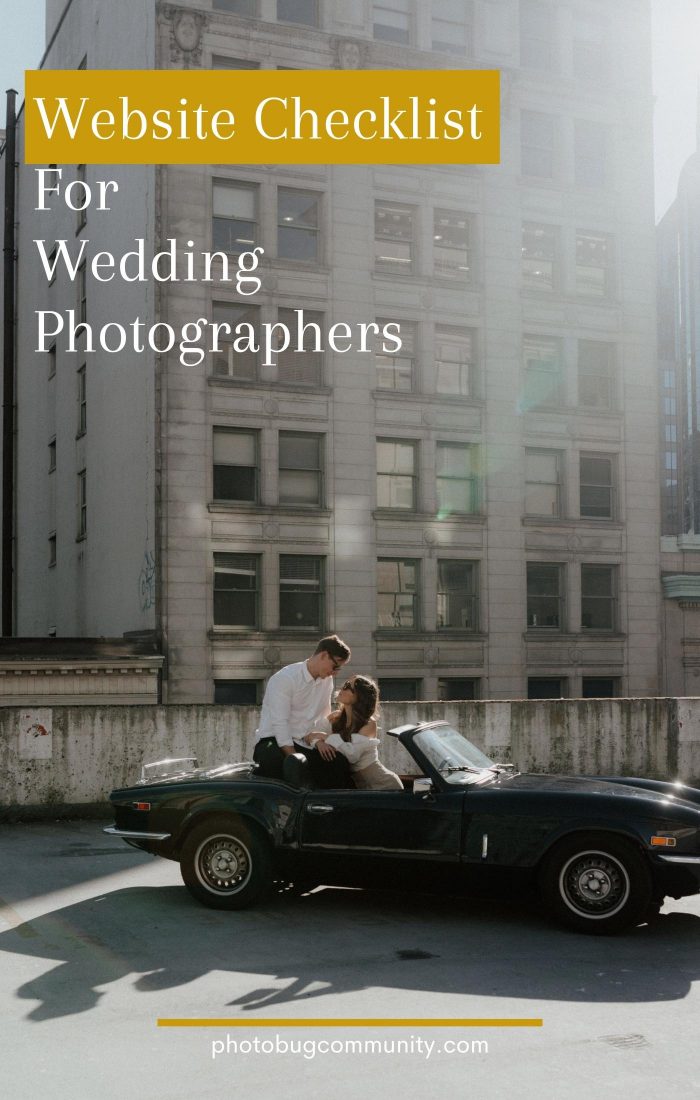
Image by The Dogwood Collective. Read on for our website checklist for wedding photographers
Your website is the number one most important marketing investment you’re making in your wedding photography business. However, it’s an easy investment to overlook. While a website isn’t something that you should set up and neglect, it’s easy to forget about when life gets crazy with checking emails, editing, and meeting clients.
If you feel like you might be at fault for neglecting your website or you’re looking to give it a complete makeover, you’re in luck. We’ve created a super-comprehensive checklist to help ensure that you’re taking full advantage of your little corner of the internet.

Image by Gaby Scheer
Website Checklist For Wedding Photographers
1. Clean, Intuitive Navigation
Your site’s navigation is basically a condensed table of contents. The biggest purpose that your navigation serves is to lead users to other content on your site. If your navigation is confusing or difficult to use, then you’ll lose out on potential clients before they even get to see your work.
To make it easy to navigate you, you should have less than five items, horizontal positioning at the top of your site or vertical positioning on the lefthand side, and descriptive and concise language–i.e., “wedding,” “about,” “contact,” etc.
2. Image Optimization
According to Website Builder Expert, one in four visitors will abandon a page if it doesn’t load within four seconds. And 46% of users won’t revisit a poorly performing website. You don’t want that to be you, which is why image optimization is so important. The larger your file sizes and/or the more files you have on one page, the slower it’s going to load. If you’re not sure how fast your website loads, use PageSpeed Insights to evaluate its current load times.
If you’re unsatisfied with your load times and want to optimize your images, consider resizing them before uploading. You can easily do this with Photoshop or Canva. Compressing the file to make it smaller is another step you can take as well.

Image by Nebula Bodas
3. Social Icons
Your social media accounts are a quick, easy way for a potential client to get a feel for your photography style. You want to make getting to your Instagram and Facebook as simple as possible, and the best way to do that is with social icons. There are many different WordPress plugins you can use for this–like Smash Balloon and Shared Counts.
4. Contact Page
The best contact page includes a simple form and a text link to your email for all other inquiries. Don’t be afraid of spam. It’s worth the risk of offering up your email for other vendors, publications, or maybe even couples who want to talk with you further outside of your contact form.
When it comes to your contact form, it’s important to ask just the right amount of questions. You may want to include fields for the wedding location, how they found you, what they envision for their day, or what drew them to your work to get the most information in one sitting. However, too many fields could potentially cause the user to give up halfway through. It’s also important to pay attention to which fields you require. Your inquirer may not have a wedding location picked yet or have a set wedding date.

Image by Natalie Sorichetti
5. Calls to Action
A call to action is a button or text link that asks a user to perform some type of action, whether that’s filling out your contact form or signing up for your newsletter. If you’re not utilizing calls to action on your website, take some time to think about what you want users to do on your site and figure out what pages make the most sense to include a call to action.
6. Keywords
One of the best ways to ensure that you rank on Google’s first page is to include specific keywords consistently. For example, if you’re a Chicago-based wedding photographer, your website should include “Chicago wedding photography” or “Wedding photographer in Chicago.” To test out how your site is currently ranking, Google your business name. You’ll be able to see where you rank, and you can ensure that your site description includes your target keyword(s), too.
7. Site Tagline
If you want couples to understand what you’re about right away, consider creating a tagline for your site–something simple and catchy. Think of it as a condensed version of your bio. Here’s an example of a tagline that pulled from Hinterland Stills‘ website:
A wedding photography collective based in Seattle, Washington that focuses on genuine couples and heavy love all around the world.
This tagline is great. It lets folks know where they’re based and what they’re about in one sentence.

Image by Urban Lens Photography
8. A Portfolio
Somewhere on your site, you should include a set of your favorite images in a portfolio that’s easily accessible from your navigation. You can even have your portfolio on your homepage, so it’s front and center when couples land on your website. If you want to take your website to the next level, we recommend choosing 8-10 recent weddings to highlight on a gallery page that’s separate from your blog.
9. FAQ or Info page
Including an FAQ page on your site helps answer common questions that may come up frequently. We know it’s frustrating to constantly answer emails about where you’re located or whether or not you’re willing to travel. You can avoid getting these emails in your inbox by having all that information available online.
To create your FAQ page, go through past conversations with couples and jot down 10-15 questions that have been asked often. Questions can cover pricing, where you’re based, if and where you’re willing to travel, if you come with a second shooter, if you offer albums, etc.
10. Newsletter Sign-Up
We can’t stress the importance of email marketing enough. With it, you can not only market yourself to potential clients, but you can also share recent work, offer giveaways, let your audience know of any promotions you may be running, and more. And because social media algorithms (specifically Instagram) are always changing, you don’t want to rely on one marketing platform to drive your business.
To build up your subscriber list, incorporate a sign-up form on your site. You can offer a freebie–like a wedding day timeline PDF–in exchange for users signing up for your newsletter. Try to send out an email once a month to keep your audience engaged.

Image by Bows & Lavender
11. A Bio
Your bio is an extremely important page on your site that you should spend time curating. When a couple loves your work and wants to know who’s on the other side of the camera, they’ll check out your bio. So, in truth, it can be the last determining factor that pushes a couple to contact you for more information. Here are some things to consider when creating your bio page:
- Let them know what you’re about, both stylistically and personally
- Don’t forget your name! This is an easy one to forget, but make sure that your first name is on your bio page somewhere so that couples know who they’re emailing and meeting. This is especially important if your business differs from your personal name
- Keep the text short and concise–300 words should do it
- Have a fellow photographer take some professional headshots so that couples know what you look like. This makes meeting up at coffee shops with your couples a much more comfortable experience
12. Updated Blog
Completely separate from your portfolio and/or gallery, your website should include a frequently updated blog that features primarily real weddings. Your blog posts should include at least 20 images that showcase full wedding day coverage–everything from getting ready to the send-off. Having and maintaining a blog on your website will not only help with your SEO, but it’s also an excellent way to showcase a more accurate version of what you’ll deliver after the wedding to couples versus just sending them your portfolio.

Image by Diana Lubbers
13. Testimonials and Reviews
While you don’t need to dedicate an entire page to testimonials, you should include them on your website. You can include them on your Information, Home, or About Me pages–all great places to showcase client reviews. While including client reviews on your website is not as credible as having reviews on Google, Wedding Wire, and The Knot, sharing testimonials on your site can give couples just one more reason to feel confident in booking you.
Ready to dive into improving your site’s SEO? Then check out these 8 SEO Tips for Wedding Photographers!

Image by Hennygraphy
Some really helpful advice here! The way Google ranks sites is constantly evolving, and although there isn’t an official list of Google ranking factors, we do know a lot about the signals that Google use across their index to rank sites accordingly.
There are some really good resources available to help you keep on track. Carrie has listed some great tools in the post, and I’d add SEMrush to her list – a great starting point to analyse your site from an SEO perspective, and to give some guidance on steps you can take to improve it.
As I’m finding with my own site – it takes time to move up the rankings! It’s also important not to focus so much on SEO optimization that your content suffers – first and foremost it’s a place to showcase you and your work to potential clients!
[…] sure to keep your website as awesome as your workflow by giving our Website Checklist for Wedding Photographers a […]